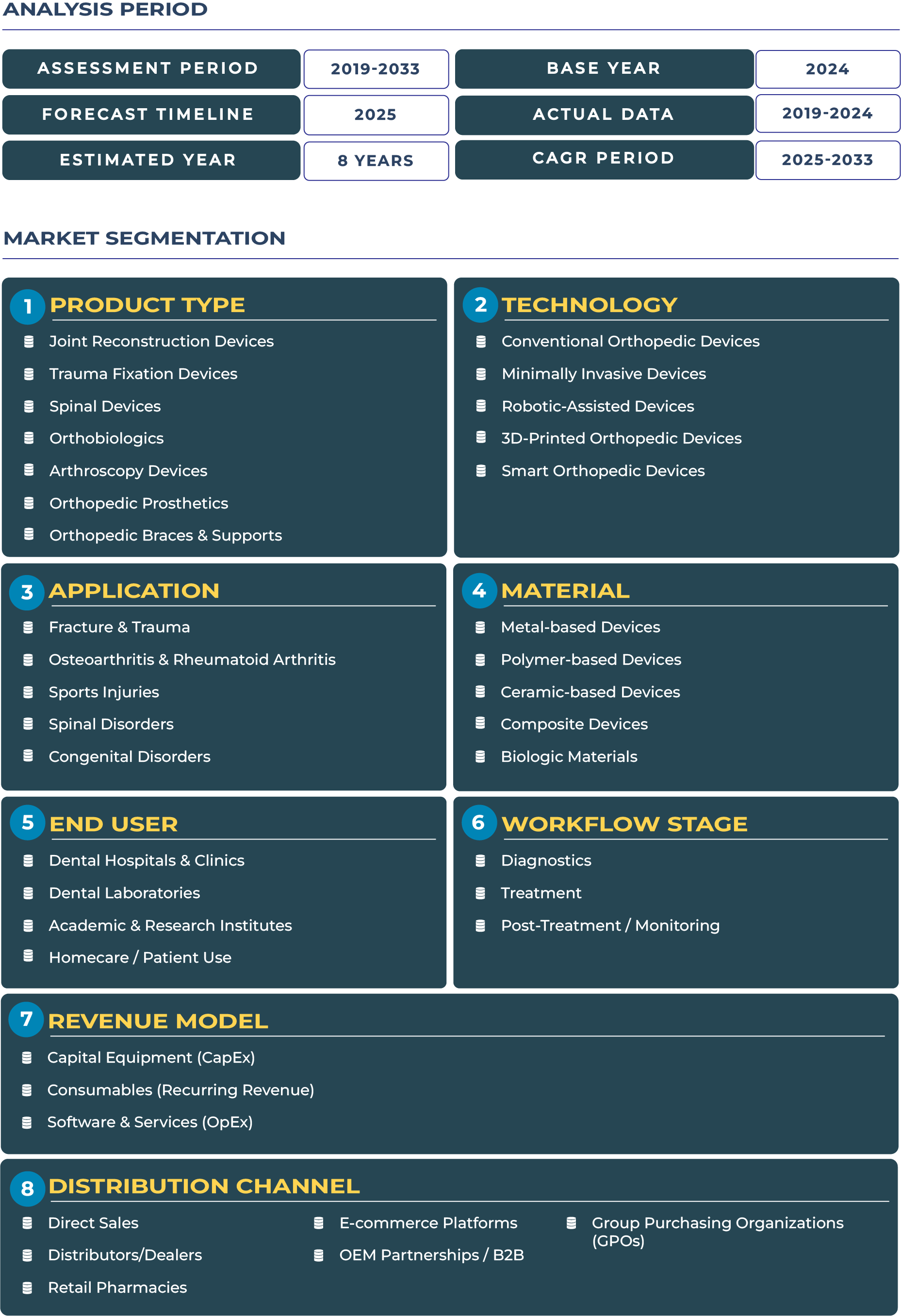Poland Orthopedic Devices Market Outlook: EU Healthcare Investments as Catalysts for Poland Orthopedic Devices Market Growth
Poland Orthopedic Devices market is entering a transformative phase, largely fueled by the country’s access to European Union healthcare funds. Recent infrastructure upgrades financed under EU structural and cohesion programs are not only modernizing hospitals but also enabling the adoption of advanced orthopedic implants, surgical instruments, and digital integration for better clinical outcomes. This structural support is creating a strong platform for orthopedic devices adoption across urban and provincial healthcare settings. According to DataCube Research, the Poland orthopedic devices market is projected to grow from USD 203.7 million in 2025 to USD 373.1 million by 2033, advancing at a CAGR of 7.9% during 2025–2033. The upward momentum reflects how EU-driven healthcare upgrades, combined with increasing demand for joint reconstruction, trauma fixation, and spinal care solutions, are positioning Poland as an attractive ecosystem for orthopedic innovations in Central and Eastern Europe.
EU-Driven Healthcare Upgrades Accelerating Orthopedic Devices Adoption
The outlook for the Poland orthopedic devices industry is strongly positive, with growth momentum supported by systemic healthcare improvements. EU-backed modernization programs have ensured that public hospitals across Poland are equipped with new surgical theaters, trauma centers, and rehabilitation facilities, making them conducive for deploying advanced orthopedic technologies. This trend is particularly visible in large cities like Warsaw, Kraków, and Wrocław, where government-funded facilities are expanding their capabilities in arthroscopy and orthopedic prosthetics. Additionally, private hospital networks are aggressively investing in ambulatory surgery centers, offering minimally invasive procedures for joint replacement and spinal corrections, thereby expanding access and reducing patient waiting times. By 2033, the orthopedic devices landscape in Poland is expected to reflect not only higher product penetration but also broader integration of digital imaging, navigation systems, and orthobiologics that enhance surgical precision and recovery rates. As domestic manufacturers and global players align strategies with EU healthcare initiatives, the orthopedic devices ecosystem is poised for strong double-digit adoption across select sub-segments.
Key Growth Drivers Powering Poland Orthopedic Devices Industry
Rapid hospital modernization is a central driver of Poland Orthopedic Devices sector, with EU funding enabling medical facilities to upgrade infrastructure and adopt world-class operating suites. Private sector expansion has further intensified competition, leading to improved access to advanced trauma fixation devices and spinal implants. The rising prevalence of osteoarthritis, sports injuries, and age-related musculoskeletal disorders is also increasing demand for joint reconstruction and arthroscopy devices. Another major driver is the strengthening of public-private partnerships, with private hospital chains forming alliances with distributors to accelerate product adoption. Furthermore, Poland’s inclusion in EU healthcare programs has lowered barriers to capital expenditure, encouraging facilities to integrate next-generation orthopedic prosthetics and orthobiologics into patient care pathways.
Challenges and Structural Restraints Facing Poland Orthopedic Devices Ecosystem
Despite the growth potential, the orthopedic devices market in Poland faces several systemic challenges. Procurement complexity across voivodeships creates inefficiencies, with local administrations applying differing budget allocation mechanisms that delay device adoption. Pricing pressures remain a key restraint, as hospitals often favor low-cost imports over higher-quality implants due to reimbursement limitations. Workforce shortages, particularly in smaller provinces, further restrict adoption of advanced orthopedic technologies, as surgical expertise and training availability remain unevenly distributed. Additionally, Poland Orthopedic Devices sector is impacted by broader geopolitical uncertainties, including supply chain disruptions linked to the Russia-Ukraine conflict, which have affected logistics for critical implant components. These barriers collectively highlight the need for coordinated reforms to harmonize procurement policies and strengthen orthopedic workforce training programs.
Emerging Trends and Opportunities in Poland Orthopedic Devices Landscape
Poland Orthopedic Devices industry is undergoing a significant shift, driven by the adoption of ambulatory surgical models that emphasize efficiency and patient convenience. EU-funded hospital upgrades have allowed for advanced arthroscopy and minimally invasive procedures to be incorporated into both public and private care settings. Private healthcare chains are also expanding aggressively in major metropolitan regions, offering competitive packages for orthopedic care and driving higher demand for trauma fixation devices and spinal stabilization implants. Opportunities lie in leveraging EU grants to position orthopedic products strategically in public tenders, ensuring subsidized access for hospitals. Distributor partnerships present another opportunity, particularly in smaller cities, where localized networks can deliver implants and devices faster than international supply chains. Moreover, value-for-money implant ranges that balance affordability with quality are increasingly attractive to hospitals constrained by reimbursement ceilings, creating space for both domestic and international manufacturers to capture new demand.
Competitive Landscape: Strategic Alignments Defining Market Dynamics
The competitive landscape of Poland Orthopedic Devices sector is evolving as both local and international players strengthen their positioning. Global companies such as Smith+Nephew are actively expanding their portfolio of joint reconstruction and sports medicine devices in Poland, leveraging EU healthcare funds to align with hospital procurement cycles. Domestic manufacturers are focusing on cost-effective implant bundles tailored for smaller hospitals, while international giants are forming partnerships with private hospital chains to expand distribution. For instance, aligning orthopedic product launches with EU grant cycles has enabled manufacturers to secure favorable adoption terms in public hospitals. The orthopedic devices industry in Poland is also witnessing consolidation, with distributors merging to create integrated supply networks that support nationwide reach. The overall competitive strategy now revolves around offering bundled solutions, incorporating not only implants but also digital surgical navigation systems and rehabilitation products, thereby enhancing value delivery to hospitals and patients.







